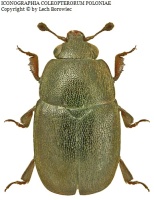Підтримуємо Вільну Україну
 We Support Free Ukraine
We Support Free Ukraine

Biodiversity Map
Taxa

Taxa selected by the filter:
Filter in use 
Taxon count: 1
-
Arthropodaphylum
Click to switch
to select orders
and filters > -
Hexapodasubphylum
Click to switch
to select orders
and filters > -
Insectaclass
Click to switch
to select orders
and filters > -
Coleopteraorder
Click to set
as the main taxon
and as a base
← of the left panel > -
Polyphagasuborder
Click to set
as the main taxon
and as a base
← of the left panel > -
Cucujiformiaseries
Click to set
as the main taxon
and as a base
← of the left panel > -
Cucujoideasuperfamily
Click to set
as the main taxon
and as a base
← of the left panel > -
Nitidulidaefamily
Click to set
as the main taxon
and as a base
← of the left panel > -
Meligethinaesubfamily
Click to set
as the main taxon
and as a base
← of the left panel > -
Meligethesgenus
Click to set
as the main taxon
and as a base
← of the left panel >
PL
YES
name status: valid name
BioMap ID: 1018059
taxon code: 3240
taxonomy checked: YES
-
Filter in use

- Views:
- Overview
- Records
- Publications
- Collections
- Publ. authors
- Illustrations
- Map
Data on distribution in Poland

Statistics
- Records: 52
- Publications: 28
- Collections: 6
- Publication authors: 31
- Illustrations (iconography): 1
- Photos (specimen/observation): lacking
Taxon description
Gatunek szeroko rozprzestrzeniony w całej Europie, występujący od Anglii i południowej Fennoskandii oraz Karelskiej ASRR aż do krajów śródziemnomorskich, notowany także z Algierii, Maroka i Kaukazu. W Polsce rzadko i sporadycznie spotykany, znany z nielicznych, rozproszonych stanowisk w siedmiu krainach. Rośliną żywicielską jest macierzanka piaskowa — Thymus serpyllum L., prócz tego postacie dojrzałe znajdowano na gwiazdnicy wielkokwiatowej — Stellaria holostea L. i komonicy zwyczajnej — Lotus corniculatus L.
Illustrations
... browse
 Meligethes
Meligethesexilis
External data sources
- Ostatnie rekordy
-
774656
 ⊡
⊡ Nitidulidae: Meligethes exilis, PL, Nizina Wielkopolsko-Kujawska, Biebrza, Szostaki, UTM WU74, 1978, leg. L. Borowiec, coll. Uniw. Wrocławski, ZBiTE
Nitidulidae: Meligethes exilis, PL, Nizina Wielkopolsko-Kujawska, Biebrza, Szostaki, UTM WU74, 1978, leg. L. Borowiec, coll. Uniw. Wrocławski, ZBiTE -
737532
 ×
× Nitidulidae: Meligethes exilis, PL (Lasoń 2003(2002))
Nitidulidae: Meligethes exilis, PL (Lasoń 2003(2002)) -
494714
 ⊡
⊡ Nitidulidae: Meligethes exilis, PL, Nizina Mazowiecka, Kampinoski P.N., Brzozówka, UTM DC79, 2010, leg. D. Marczak, coll. Kampinoski P.N. (Lasoń et al. 2011)
Nitidulidae: Meligethes exilis, PL, Nizina Mazowiecka, Kampinoski P.N., Brzozówka, UTM DC79, 2010, leg. D. Marczak, coll. Kampinoski P.N. (Lasoń et al. 2011) -
480247
 ×
× Nitidulidae: Meligethes exilis, PL, coll. ISEZ PAN
Nitidulidae: Meligethes exilis, PL, coll. ISEZ PAN -
3735
 ×
× Nitidulidae: Meligethes exilis, PL, «gubernia warszawska» (Jacobson 1915b, Burakowski et al. 1986a)
Nitidulidae: Meligethes exilis, PL, «gubernia warszawska» (Jacobson 1915b, Burakowski et al. 1986a) -
3734
 ○
○ Nitidulidae: Meligethes exilis, PL, «Hrabstwo Kłodzkie», UTM XR18 (Letzner 1871c, Burakowski et al. 1986a)
Nitidulidae: Meligethes exilis, PL, «Hrabstwo Kłodzkie», UTM XR18 (Letzner 1871c, Burakowski et al. 1986a) -
3733
 ×
× Nitidulidae: Meligethes exilis, PL, «Galicja zachodnia» (Nowicki 1873b, Burakowski et al. 1986a)
Nitidulidae: Meligethes exilis, PL, «Galicja zachodnia» (Nowicki 1873b, Burakowski et al. 1986a) -
3732
 ×
× Nitidulidae: Meligethes exilis, PL, «Galicja» (Łomnicki 1884a, Burakowski et al. 1986a)
Nitidulidae: Meligethes exilis, PL, «Galicja» (Łomnicki 1884a, Burakowski et al. 1986a) -
3731
 ×
× Nitidulidae: Meligethes exilis, PL, «Śląsk» (Kuhnt 1912, Burakowski et al. 1986a)
Nitidulidae: Meligethes exilis, PL, «Śląsk» (Kuhnt 1912, Burakowski et al. 1986a) -
3730
 ×
× Nitidulidae: Meligethes exilis, PL, «Polska zachodnia» (Nunberg 1976a, Burakowski et al. 1986a)
Nitidulidae: Meligethes exilis, PL, «Polska zachodnia» (Nunberg 1976a, Burakowski et al. 1986a) - ... more
- Powiązane publikacje
-
Lasoń A., Marczak D., Kubisz D., Tykarski P. 2011. Kateretidae and Nitidulidae (Coleoptera) of the Mazovian Lowland. Pol. Pismo Ent., 80(2):299-320.
 full text
full text Show records
Show records -
Audisio , Cline , De Biase , Antonini , Mancini 2009b. Preliminary re-examination of genus-level taxonomy of the pollen beetle subfamily Meligethinae (Coleoptera: Nitidulidae). Acta Ent. Mus. Nat. Pragae, 49(2):341-504.
 Show records
Show records -
Lasoń A. 2003(2002). Meligethes jelineki Audisio, 1976 – nowy dla fauny Polski gatunek chrząszcza oraz nowe dane o rozsiedleniu przedstawicieli rodziny Nitidulidae (Coleoptera) na Podlasiu. Wiad. Entomol., 21(4):205-212.
 full text
full text Show records
Show records -
Audisio , Jelinek , Mariotti , De Biase 2000. The Coleoptera Nitidulidae and Kateretidae from Anatolian, Caucasian and Middle East regions. Biogeographia, XXI:241-354.
 Show records
Show records -
Kirk-Spriggs 1994. The Meligethes (Coleoptera: Nitidulidae) of Montgomeryshire (Vice-County 47). Br. J. Ent. Nat. Hist., 7:71-76.
 Show records
Show records - ... more






